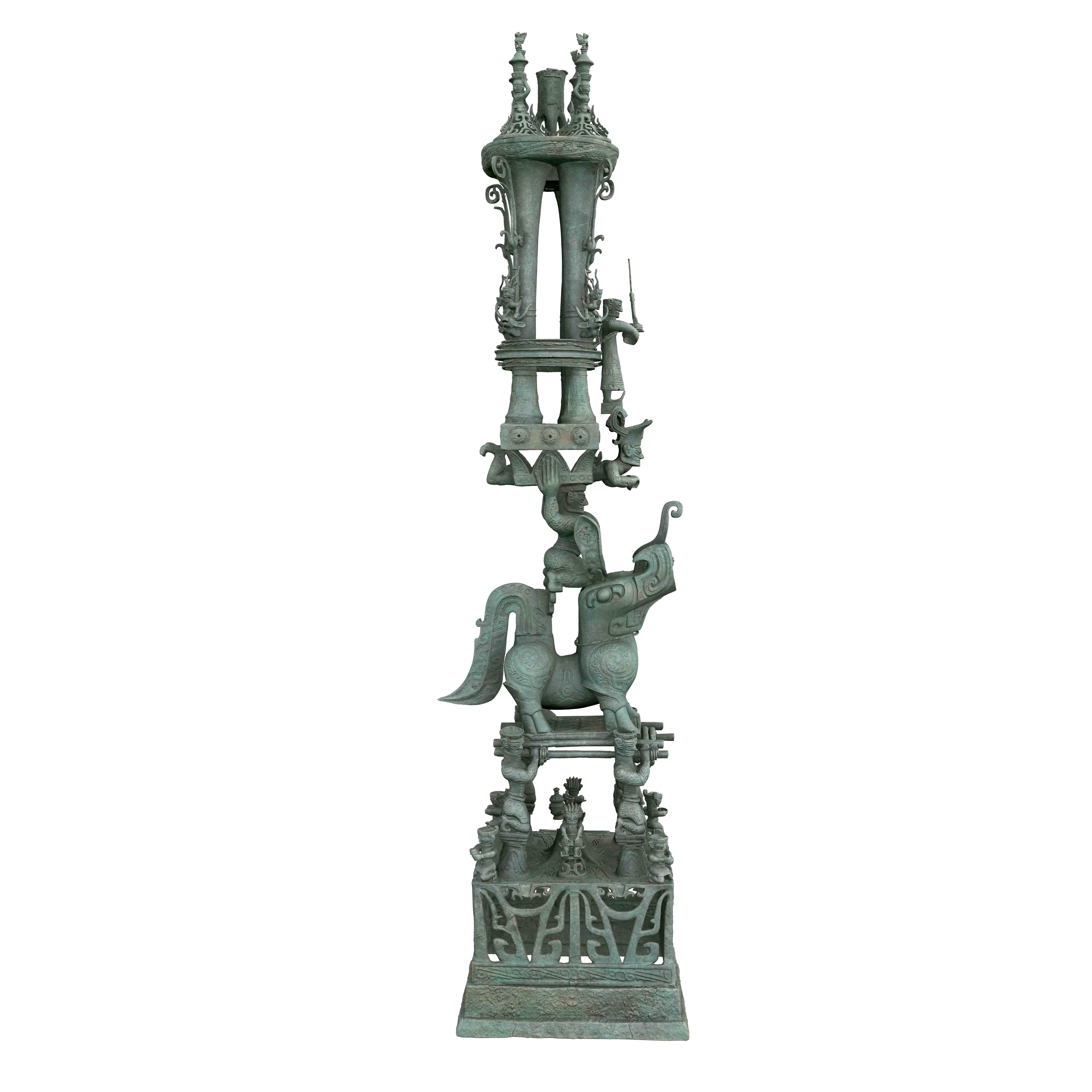Bronze Altar

This composite artifact was reconstructed using the bronze mythical beast from Pit No. 8, a perforated platform adorned with 13 small bronze figurines, the bronze figure holding a ritual vessel from Pit No. 3, the bronze bird-holding standing figure from Pit No. 3, and the kneeling bronze figures with ritual vessels from Pits No. 2 and No. 7.
Base of the Bronze Altar
Excavated in June 2022 from the northeastern corner of Pit No. 8 in the Sanxingdui sacrificial area, the altar base has a multi-tiered pagoda-like structure, standing approximately 90 cm tall and about 40 cm square at the base. The altar can be divided into three main sections. The lowest section consists of a perforated pedestal decorated with plant-like openwork patterns. The middle section forms a ceremonial platform, where 13 small bronze figurines are arranged. The outermost figurines are divided into three groups, each containing four figures. The first group kneels at the four corners of the platform, hands in a gripping posture. The second group, with upright hair and skirted attire, sits solemnly on small perforated platforms at the center of each altar side. The third group consists of taller and more robust figures, each kneeling on a circular pedestal. These four figures collectively lift a palanquin-like structure composed of eight bronze rods. At the center of the middle platform, a small mountain-shaped protrusion supports a kneeling figure, who carries a round ritual vessel strapped to their back.
Bronze Mythical Beast
Above the palanquin structure, the upper section of the altar features a small bronze mythical beast, resembling a hybrid of a dog and a horse. Between its head and tail sits a kneeling human figure, whose upper body is now missing. The entire altar is highly complex in structure, employing sophisticated casting and assembly techniques to connect individual pre-cast components with precision, forming a stable yet intricate large bronze artifact. More significantly, the numerous human figures in the central section of the altar create a vivid depiction of a ritual ceremony, possibly illustrating the division of roles among different participants in major Sanxingdui religious rites and reflecting their religious beliefs.
Bronze Figure Holding the Altar
At the base of the altar, a damaged bronze figure is depicted with both hands raised above the head, gripping a mountain-shaped pedestal and supporting the square-and-round altar above. The square base of the altar features two reclining human figures, with their upper bodies and legs extending outward. The altar is supported by four slender bronze columns, stabilized by a ring-shaped brace in the lower-middle section. The central figure wears a headdress, has prominent eyes, a straight nose, large ears, and a wide mouth. The figure's hands are positioned in a gripping posture, while the headdress supports a square pedestal on which another standing figure is placed. This standing figure has a square jaw, thick eyebrows, large eyes, a straight nose, a broad mouth, and long rectangular ears with holes in the earlobes. The hair is braided and hangs down the back. The figure is dressed in multi-layered, ornate garments and boots, and stands atop a square platform decorated with eye motifs. The figure's long, slender body is upright, with exaggeratedly large arms and hands clasped in front of the chest—left hand above, with the pinky finger raised, and right hand below. The figure holds a bird, which is now partially broken, leaving only the head and neck. The bird has a slender, beaded-patterned neck, a hooked beak adorned with a kuilong (mythical dragon) motif, and a tail curling forward. Two of the altar's four supporting columns are adorned with three-dimensional "dragon-seizing-bull" sculptures. The dragons have elongated, flowing bodies, appearing to descend from the heavens, with their front claws gripping the bull's horns while their rear claws press against the middle of the columns. The dragon heads face forward, with long rectangular snouts, dual ears, and tall, backward-extending horns. A ritual jade blade is affixed to the front of the dragon's nose, featuring a gradually widening shape towards the front and a slightly curved, pointed tip. The dragon's mouth is open, revealing interlocking sharp teeth, while its long eyes are slightly convex. The prominent nose bridge has "S"-shaped whiskers that curve backward from the upper mouth. The dragon's well-defined jawline extends into an upward-curving chin, and its straight neck connects seamlessly with its slender body. The upper sections of the other two supporting columns have holes, suggesting they may have also featured similar "dragon-seizing-bull" sculptures. The altar's four columns support a circular plate, upon which rest four trumpet-shaped pedestals, each holding a kneeling human figure. The pedestals are intricately perforated and decorated with evenly spaced ridges, with flat tops bordered by a raised band. The kneeling figures, bare-chested with prominent nipples, wear skirts tied at the waist. Their hands raise a zun topped with a trumpet-shaped base—likely once holding a bird, per archaeological findings (K7). A central cylindrical pillar, embedded into the mouths of the four gu vessels, rises between the pedestals.